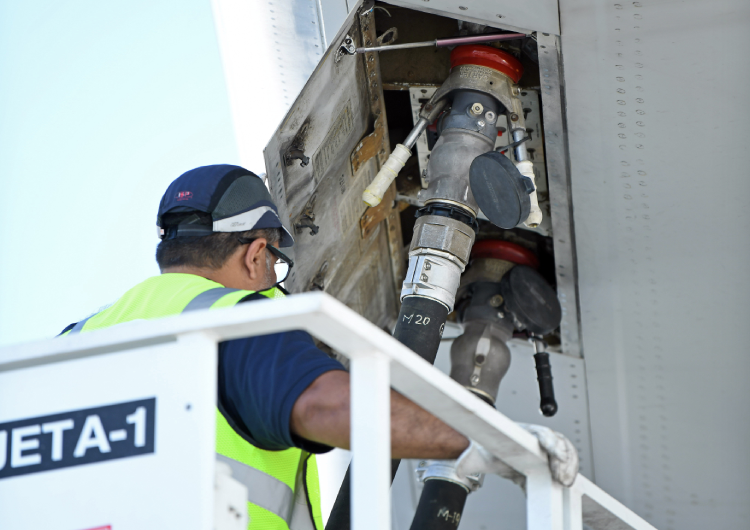The bridge between finance and sustainability is crucial if aviation is to achieve its net zero goal.
Sustainable aviation fuels work. Reducing carbon emissions up to 80%, they are a proven drop-in technology and certified for 50% blends in engines. With 100% carbon reduction and 100% certification on the way, the future from a technology perspective looks bright.
But there are challenges. SAF are more expensive than Jet A1 and supply is limited.
Marie Owens Thomsen, IATA’s Senior Vice President, Sustainability and Chief Economist says the complexities involved mean there are no easy solutions. But, just as Thomsen’s role now combines sustainability with economics, certain financial truths need to be understood to at least get SAF on an equal footing with conventional jet fuel.
“Governments must start the ball rolling with right policies and then the financial side will follow,” she says. “And the first thing governments should do is create supporting policies to increase SAF production.”
Countries that have signed the Paris Agreement to limit global warming to 1.5C are still subsidizing an overwhelming number of products and services that are based on fossil fuel. In the European Union alone, some €50 billion is spent in this area annually. Although, overall, more EU money goes to green energy than brown energy that is not necessarily true of individual countries.
“To date most countries don’t incentivize SAF production,” says Thomsen. “It’s extraordinary. It means that refineries that could produce SAF aren’t doing so. As we see more renewable fuel production capacity coming online that doesn’t necessarily mean that SAF will be produced, as bio-diesel remains the cheaper production option.”
Mandates
Instead of incentivizing production, some governments are mandating SAF output. Mandates could force producers to focus on using proven SAF pathways like HEFA (cooking oil) at the expense of other feedstock pathways that require more research or e-fuels. It will also be a barrier to entry for potential other producers.
“A mandate is not an action that makes sense,” Thomsen suggests. “We have a supply problem, not a demand problem. More than 450,000 commercial flights have been operated using SAF and every drop ever produced has been bought and used. That is why incentives make more sense.”
The transition to affordable SAF is possible. Solar and wind are now the cheapest energies available, for example. And SAF doesn’t need to become cheap in absolute terms—a relative price advantage compared with Jet A1 is enough. That would make SAF the most profitable option to take, provided production follows.
“There are so many other factors that will affect the price of SAF,” Thomsen warns. “The availability and price of feedstocks, for example, but also the availability of green energy to develop e-fuels that are still in the research stage.”
But the point is not what the price of SAF will be, but the fact that it cannot be an inferior investment option. A clear policy framework that investors trust to venture into this nascent field is essential. This means policies that are forward looking, stable, and harmonized.
Silo thinking
The complexities surrounding SAF are mirrored in other sustainability initiatives. Sustainability projects generally have a higher risk profile than large blue-chip companies, which rules out most investors. That needs to change if the industry is to secure the finance needed to achieve net zero.
A major issue is silo thinking. “Sustainability is a systemic problem, and a system is not simply a sum of its parts,” says Thomsen. “There are endless dynamics involved in the aviation ecosystem due to the complex and nuanced interactions. But we rarely see a systems approach, especially from governments, which is why we get unintended consequences. A lack of systemic thinking tends to produce unintended consequences in policy making.”
The industry has devised a conceptual path to net zero and work is ongoing to flesh this out. The energy, infrastructure, funding, technologies, and policies required all need to be integrated into the roadmap. All aviation stakeholders are involved to ensure collaboration and promote this systemic approach.
A first step is ensuring sustainability has the right metrics for the industry to understand where it stands and where it can make progress. These metrics need to be defined, with the definitions agreed globally for maximum applicability.
Second, Thomsen insists that every possibility for carbon reduction must be explored, and no progress is too small when it comes to reducing the industry’s carbon footprint. Sustainability initiatives will be a work in progress for decades yet and how they will all play out is unknown.
For instance, electric batteries will probably not power larger commercial aircraft over longer distances before 2050. But they could play their part in powering small aircraft on short-haul flights. “That’s better than not having those flights at all,” says Thomsen. “Because short haul can be a vital connector for remote communities.
Carbon offsets have been criticized too, but the industry has committed more than $30 billion to date. Offsets are an interim solution, but a necessary part of the transition, particularly for aviation, as the industry lacks immediate options at scale. The goal is to diminish the industry’s reliance on offsets as technologies and SAF are more widely available.
“There is no magic wand,” Thomsen concludes. “We must use every possible solution, even the ones with limited impact. I am frustrated by debates that paint the situation in black and white—this is the right way forward, that isn’t. We don’t have that luxury yet. Maybe closer to 2050 we can be choosy about how we reduce carbon but right now we need everything. There is value in small-ticket items. They can add up to something meaningful and they are often cheap, available, and easy to implement.”
Credit | iStock



